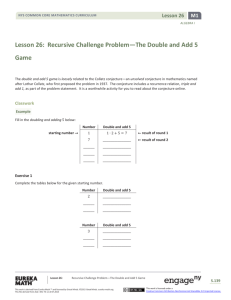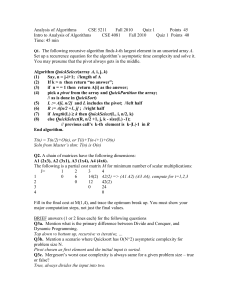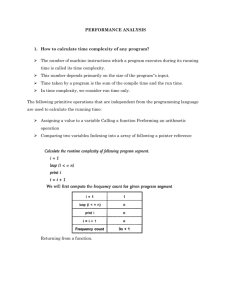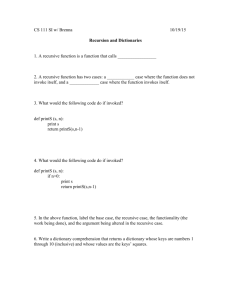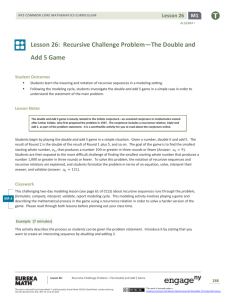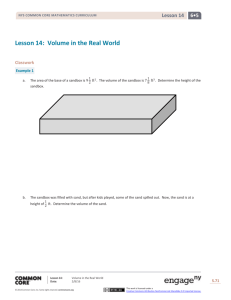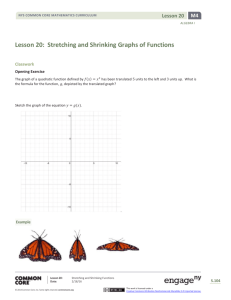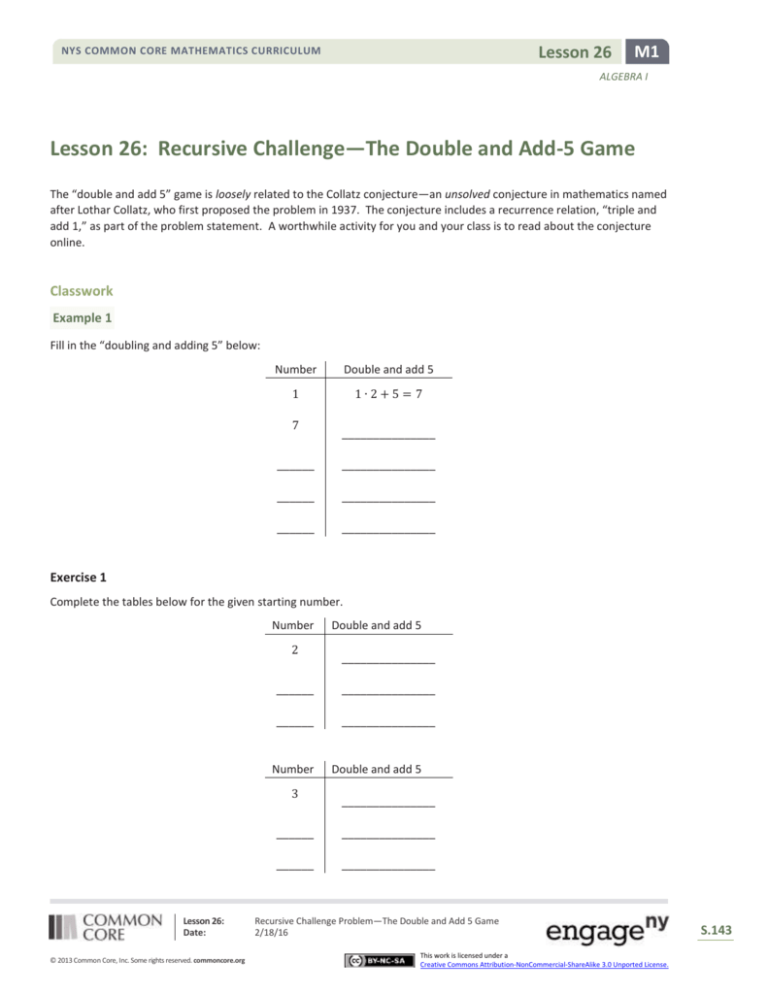
Lesson 26
NYS COMMON CORE MATHEMATICS CURRICULUM
M1
ALGEBRA I
Lesson 26: Recursive Challenge—The Double and Add-5 Game
The “double and add 5” game is loosely related to the Collatz conjecture—an unsolved conjecture in mathematics named
after Lothar Collatz, who first proposed the problem in 1937. The conjecture includes a recurrence relation, “triple and
add 1,” as part of the problem statement. A worthwhile activity for you and your class is to read about the conjecture
online.
Classwork
Example 1
Fill in the “doubling and adding 5” below:
Number
Double and add 5
1
1∙2+5= 7
7
_______________
______
_______________
______
_______________
______
_______________
Exercise 1
Complete the tables below for the given starting number.
Number
2
_______________
______
_______________
3
© 2013 Common Core, Inc. Some rights reserved. commoncore.org
_______________
______
Number
Lesson 26:
Date:
Double and add 5
Double and add 5
_______________
______
_______________
______
_______________
Recursive Challenge Problem—The Double and Add 5 Game
2/18/16
S.143
This work is licensed under a
Creative Commons Attribution-NonCommercial-ShareAlike 3.0 Unported License.
143
Lesson 26
NYS COMMON CORE MATHEMATICS CURRICULUM
M1
ALGEBRA I
Exercise 2
Given a starting number, double it and add 5 to get the result of round 1. Double the result of Round 1 and add 5, and so
on. The goal of the game is to find the smallest starting whole number that produces a result of 100 or greater in 3
rounds or less.
Exercise 3
Using a generic initial value, 𝑎0 , and the recurrence relation, 𝑎𝑖+1 = 2𝑎𝑖 + 5, for 𝑖 ≥ 0, find a formula for 𝑎1 , 𝑎2 , 𝑎3 , 𝑎4 in
terms of 𝑎0 .
Lesson 26:
Date:
© 2013 Common Core, Inc. Some rights reserved. commoncore.org
Recursive Challenge Problem—The Double and Add 5 Game
2/18/16
S.144
This work is licensed under a
Creative Commons Attribution-NonCommercial-ShareAlike 3.0 Unported License.
144
Lesson 26
NYS COMMON CORE MATHEMATICS CURRICULUM
M1
ALGEBRA I
Problem Set
1.
Write down the first 5 terms of the recursive sequences defined by the initial values and recurrence relations below:
a.
𝑎0 = 0 and 𝑎𝑖+1 = 𝑎𝑖 + 1, for 𝑖 ≥ 0,
b.
𝑎1 = 1 and 𝑎𝑖+1 = 𝑎𝑖 + 1, for 𝑖 ≥ 1,
c.
𝑎1 = 2 and 𝑎𝑖+1 = 𝑎𝑖 + 2, for 𝑖 ≥ 1,
d.
𝑎1 = 3 and 𝑎𝑖+1 = 𝑎𝑖 + 3, for 𝑖 ≥ 1,
e.
𝑎1 = 2 and 𝑎𝑖+1 = 2𝑎𝑖 , for 𝑖 ≥ 1,
f.
𝑎1 = 3 and 𝑎𝑖+1 = 3𝑎𝑖 , for 𝑖 ≥ 1,
g.
𝑎1 = 4 and 𝑎𝑖+1 = 4𝑎𝑖 , for 𝑖 ≥ 1,
h.
𝑎1 = 1 and 𝑎𝑖+1 = (−1)𝑎𝑖 , for 𝑖 ≥ 1,
i.
𝑎1 = 64 and 𝑎𝑖+1 = (− )𝑎𝑖 , for 𝑖 ≥ 1,
1
2
2.
Look at the sequences you created in problems 1b through 1d. How would you define a recursive sequence that
generates multiples of 31?
3.
Look at the sequences you created in problems 1e through 1g. How would you define a recursive sequence that
generates powers of 15?
4.
The following recursive sequence was generated starting with an initial value of 𝑎0 , and the recurrence relation
𝑎𝑖+1 = 3𝑎𝑖 + 1, for 𝑖 ≥ 0. Fill in the blanks of the sequence:
(_______, _______, 94, _______, 850, ______).
5.
For the recursive sequence generated by initial value, 𝑎0 , and recurrence relation, 𝑎𝑖+1 = 𝑎𝑖 + 2, for 𝑖 ≥ 0, find a
formula for 𝑎1 , 𝑎2 , 𝑎3 , 𝑎4 in terms of 𝑎0 . Describe in words what this sequence is generating.
6.
For the recursive sequence generated by initial value, 𝑎0 , and recurrence relation, 𝑎𝑖+1 = 3𝑎𝑖 + 1, for 𝑖 ≥ 0, find a
formula for 𝑎1 , 𝑎2 , 𝑎3 in terms of 𝑎0 .
Lesson 26:
Date:
© 2013 Common Core, Inc. Some rights reserved. commoncore.org
Recursive Challenge Problem—The Double and Add 5 Game
2/18/16
S.145
This work is licensed under a
Creative Commons Attribution-NonCommercial-ShareAlike 3.0 Unported License.
145

